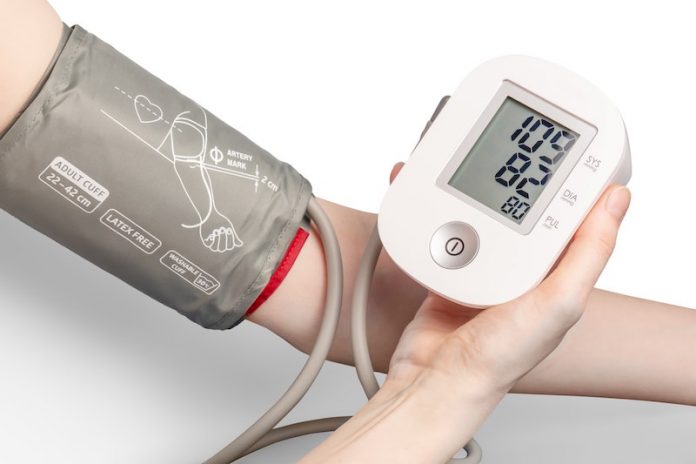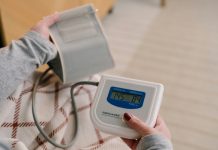
A doctor’s presence during a blood pressure reading triggers a “fight or flight” response that can affect the results, say researchers who studied the effect by measuring nerve activity.
“White coat hypertension” – the phenomenon when blood pressure rises in some people who are measured by a medical professional – has been known about for decades. It occurs in about a third of people with high blood pressure.
In a small study published Monday in the American Heart Association journal Hypertension, Italian researchers examined the effect’s roots by measuring blood pressure, heart rate and nerve traffic in the skin and muscles with and without a doctor present.
The researchers found a “drastic reduction” in the body’s alarm response when a doctor was not present, said co-lead author Dr. Guido Grassi, professor of internal medicine at the University of Milano-Bicocca in Milan.
An increase in blood pressure and heart rate is part of the body’s reaction to a perceived threat, said Dr. Meena Madhur, associate professor of medicine in the divisions of clinical pharmacology and cardiology at Vanderbilt University in Nashville, Tennessee.
“If you’re out in the wild and a bear was charging after you, you’d want your blood vessels in your skin, for example, to constrict and the blood vessels in your muscles to dilate to provide more blood flow to those organs so that you can run really fast,” said Madhur, She was not involved in the new research.
The study included 18 people, 14 of them men, with mild to moderately high blood pressure that was not being treated. Each participant was examined in a lab, where an electrode measured nerve activity in the skin and muscles.
Readings were taken twice in the presence of a doctor and twice without.
In the doctor’s presence, both blood pressure and heart rate rose, and nerve traffic patterns to the skin and skeletal muscle suggested a classic fight or flight reaction.
By contrast, when readings were taken without a doctor present, cardiovascular and neural responses were “strikingly different,” the researchers wrote. Indications of the fight or flight response were “entirely absent”.
Peak systolic blood pressure (the first number in a reading, a measure of the pressure against the artery walls when the heart beats) was, on average, about 14 points lower when the participant was alone than when a doctor was present. Being alone also lowered the peak heart rate by nearly 11 beats per minute.
This was the first study to document changes in the sympathetic nervous system – which regulates the fight or flight response – in relation to whether a doctor was overseeing a blood pressure measurement, the researchers wrote.
The findings highlight the complexity of blood pressure measurements and how they are affected by involuntary reactions of the nervous system, Grassi said.
“Measurements without the doctor’s presence may better reflect true blood pressure values.”
Although the concept of white coat hypertension is not new, Madhur said, “this just drives home the fact that we should be more conscious of how the blood pressure is taken in the clinic.”
The American Medical Association and AHA issued a joint report last year that endorsed more self-measurement of blood pressure at home.
The complexity of the testing kept the size of the study small, researchers said.
They also said follow-up research would need to look at the effect of blood pressure medication. That’s because such medications could affect the fight or flight response, Madhur said.
She said the work should be repeated with more women to examine possible sex differences.
And she’d be interested in seeing whether people have the same response to nurses and other medical professionals as they did to doctors in this study.
Grassi said earlier work shows the white coat effect is less pronounced when nurses take blood pressure measurements.
Overall, Madhur said, this latest research drives home the need for people to handle blood pressure measurements with care.
“I always tell my patients that we really can’t rely on a single office blood pressure measurement, because that’s just a random point in time,” she said.
To take an accurate reading at home, be sure to sit still, with your back straight and supported and your feet on the floor, and wait at least a few minutes before recording your blood pressure, Madhur said.
Take multiple readings over the course of a week, at the same time each day, and bring that log to your doctor’s appointment.
Those at-home readings should be the ones used for planning treatment, she said.
“But,” Madhur added, “if we are going to do an office blood pressure reading, it should be taken with the doctor not in the room.”
Written by Michael Merschel.
If you care about blood pressure health, please read studies about this blood pressure drug may increase risk of sudden cardiac arrest and findings of this high blood pressure drug may hurt your gut health.
For more information about high blood pressure, please see recent studies about which blood pressure number matters most? It may depend on your age and results showing a new way to treat drug-resistant high blood pressure.



